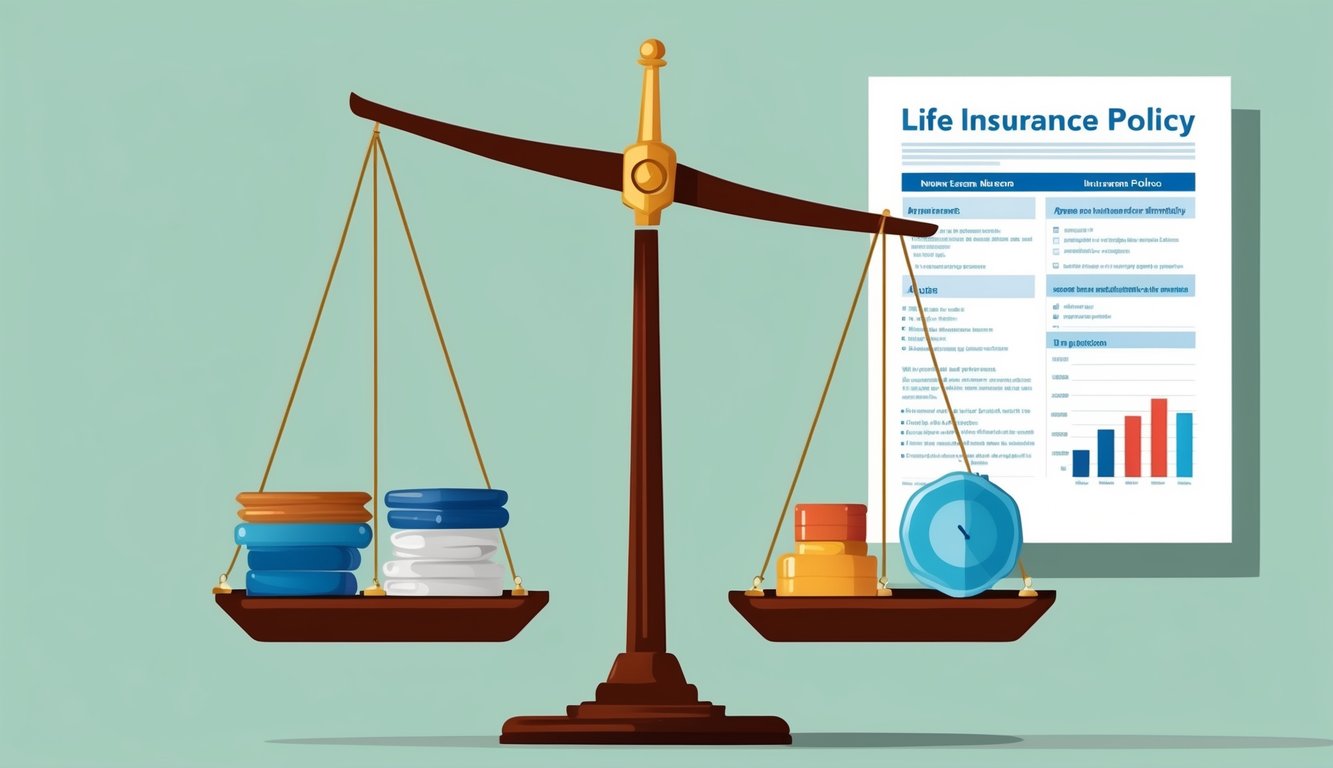Life insurance provides financial protection for your loved ones in the event of your passing.
When you shop for a policy, you may notice that premiums can vary widely between individuals.
Understanding the factors that influence these costs can help you make informed decisions about your coverage.
Several key elements determine the price of your life insurance premium.
Familiarizing yourself with these factors can help you take steps to potentially lower your costs and secure the coverage you need at a more affordable rate.
From personal characteristics to lifestyle choices, various aspects of your life play a role in how insurance companies calculate your premiums.
1) Age
Your age is a crucial factor in determining your life insurance premium.
Insurance companies consider age as a primary indicator of life expectancy and risk.
Generally, you will pay lower life insurance premiums when you are younger.
This is because insurance companies view younger individuals as having a longer life expectancy and being less risky to insure.
As you get older, your life insurance costs will tend to increase.
This is due to the higher likelihood of health issues and shorter remaining life expectancy as you age.
If you’re considering life insurance, it’s often advantageous to purchase a policy when you’re younger.
Doing so can help you lock in lower rates for the duration of your policy term.
Some insurers offer policies with level premiums, meaning your rates won’t increase as you age.
However, these policies usually have higher initial costs compared to those with increasing premiums.
Each insurance company has its own age-based pricing structure.
It’s wise to compare quotes from multiple providers to find the best rates for your age group.
2) Gender

Your gender plays a significant role in determining your life insurance premium.
Insurance companies use statistical data to assess risk, and gender is one factor they consider.
Generally, women pay less for life insurance than men.
This is because women tend to have a longer life expectancy on average.
Insurance providers view this as a lower risk, resulting in more favorable rates for female policyholders.
Men, on the other hand, often face higher premiums due to their statistically shorter lifespans.
This difference can be substantial, with male applicants sometimes paying 30-50% more for the same coverage as their female counterparts.
The impact of gender on your premium can vary based on other factors as well.
For instance, the difference in rates between men and women tends to be more pronounced in permanent life insurance policies compared to term life insurance.
It’s important to note that while gender is a factor, it’s not the only one insurers consider.
Your age, health status, lifestyle, and occupation also influence your premium.
When shopping for life insurance, remember that rates can vary significantly between providers.
It’s always wise to compare quotes from multiple insurers to find the best coverage for your specific situation.
3) Medical history
Your medical history plays a crucial role in determining your life insurance premium.
Insurance companies carefully evaluate your health status to assess the risk of insuring you.
Various health conditions can impact your premiums.
These may include heart disease, diabetes, cancer, and chronic respiratory issues.
The severity and management of these conditions are taken into account.
Your current health status is important, but insurers also consider your past medical experiences.
This includes previous surgeries, hospitalizations, and treatments you’ve undergone.
Family medical history is another factor that insurers examine.
Genetic predispositions to certain illnesses can influence your premium rates.
Insurance companies may request access to your medical records or require you to undergo a medical examination.
This helps them get a comprehensive view of your health.
It’s important to be honest about your medical history when applying for life insurance.
Withholding information could lead to claim denials or policy cancellations in the future.
If you have pre-existing conditions, don’t assume you can’t get coverage.
Many insurers offer policies tailored to different health profiles, albeit at potentially higher premiums.
Maintaining good health through regular check-ups, following prescribed treatments, and adopting a healthy lifestyle can positively impact your insurance rates over time.
4) Smoking status

Your smoking status significantly impacts your life insurance premium.
Smokers typically pay much higher rates for coverage due to the increased health risks associated with tobacco use.
Insurance companies consider smokers to be at higher risk of premature death.
This assessment leads to substantially higher premiums compared to non-smokers.
If you quit smoking, you can potentially lower your life insurance costs.
Many insurers will reclassify you as a non-smoker after a certain period without tobacco use, often 12 months or more.
The difference in premiums between smokers and non-smokers can be substantial.
For example, a 20-year $500,000 term life policy might cost a male smoker $2,025 annually, compared to just $797 for a non-smoker.
When applying for life insurance, you’ll need to disclose your smoking status honestly.
Insurers may verify this information through medical exams or tests that can detect tobacco use.
Keep in mind that most insurance companies consider all forms of tobacco use, including cigars, pipes, chewing tobacco, and e-cigarettes, when determining your smoking status.
5) Occupation

Your job can significantly influence your life insurance premium.
Insurance companies assess occupational risks when determining rates.
High-risk professions often lead to higher premiums.
These include jobs with increased physical danger, such as firefighters, police officers, and construction workers.
Office jobs or low-risk occupations typically result in lower premiums.
If you work in fields like accounting, teaching, or administration, you may pay less for life insurance.
Some insurers consider job-related stress levels.
High-stress professions might face slightly higher rates due to potential health impacts.
Travel frequency for work can affect your premium.
If your job requires frequent international trips, especially to high-risk areas, you might see increased rates.
Your specific duties within a profession matter.
For example, a pilot who flies commercial jets may have different rates than one who operates small planes.
Income level tied to your occupation can impact coverage amounts.
Higher-earning professions often require larger policies, potentially increasing overall costs.
It’s important to provide accurate information about your occupation when applying for life insurance.
Misrepresenting your job could lead to claim denials or policy cancellations.
6) Hobbies
Your hobbies can significantly impact your life insurance premiums.
Insurance companies assess risk based on your lifestyle, including activities you engage in regularly.
High-risk hobbies like skydiving, scuba diving, and rock climbing may lead to higher premiums.
These activities are considered dangerous and increase the likelihood of accidents or fatalities.
Racing, whether with cars, motorcycles, or boats, is another hobby that can affect your rates.
The speed and potential for crashes make it a concern for insurers.
Even less extreme hobbies can influence your premiums.
For example, if you enjoy private piloting, you might face higher rates due to the perceived risks associated with flying small aircraft.
Some insurers may exclude coverage for injuries or death resulting from certain hobbies.
Others might offer riders to cover these activities for an additional cost.
If you participate in risky hobbies, be honest when applying for life insurance.
Failing to disclose such activities could lead to claim denials in the future.
Consider how frequently you engage in these hobbies.
Occasional participation may have less impact on your premiums than regular involvement.
Some insurance companies specialize in coverage for high-risk activities.
Shopping around can help you find the best rates if you have adventurous hobbies.
7) Lifestyle choices
Your lifestyle can significantly impact your life insurance premiums.
Insurers consider various factors when determining your rates, as certain habits and activities may increase your risk profile.
Smoking status is a major consideration for insurance companies.
If you smoke tobacco, you’ll likely pay substantially higher premiums compared to non-smokers.
Insurance providers view smoking as a significant health risk.
Your alcohol consumption habits also play a role.
Moderate drinking may not affect your rates, but excessive alcohol use can lead to higher premiums due to associated health risks.
High-risk hobbies and occupations can increase your life insurance costs.
Activities like skydiving, rock climbing, or racing cars are considered high-risk and may result in higher premiums.
Your driving record is another factor insurers examine.
A history of traffic violations or accidents can lead to increased rates, as it may indicate a higher risk of premature death.
Regular exercise and maintaining a healthy diet can positively influence your premiums.
These habits often contribute to better overall health, which insurers view favorably.
Your travel habits may also affect your rates.
Frequent trips to high-risk countries or regions can result in higher premiums due to increased safety concerns.
By making positive lifestyle choices, you can potentially lower your life insurance premiums.
Quitting smoking, limiting alcohol intake, and adopting healthier habits can improve your risk profile in the eyes of insurers.
Understanding Life Insurance Premiums

Life insurance premiums are the regular payments you make to maintain your policy coverage.
The cost varies based on several key factors that insurers consider when determining your individual premium rate.
Definition of Life Insurance Premiums
Life insurance premiums are the amounts you pay to your insurance company to keep your policy active.
These payments can be made monthly, quarterly, semi-annually, or annually, depending on your preference and the insurer’s options.
The premium you pay ensures that your beneficiaries will receive the death benefit if you pass away while the policy is in force.
Your premium rate is calculated based on the likelihood that the insurer will have to pay out the death benefit.
The higher the perceived risk, the more you’ll pay for coverage.
Factors Influencing Premiums
Several factors impact your life insurance premium:
- Age: Younger applicants typically pay lower premiums.
- Gender: Women often pay less due to longer average life expectancy.
- Health: Your current health status and medical history affect rates.
- Smoking: Smokers pay significantly higher premiums.
- Occupation: High-risk jobs may increase premiums.
- Lifestyle: Dangerous hobbies can lead to higher rates.
- Family medical history: Hereditary conditions may impact pricing.
Your choice of policy type also affects premiums.
Term life insurance is generally less expensive than permanent life insurance.
The coverage amount and policy length you select will influence your premium as well.
Role of Health in Determining Premiums

Your health status significantly impacts life insurance premiums.
Insurance companies assess your current health condition and medical history to determine the level of risk you present.
Impact of Pre-existing Conditions
Pre-existing conditions can substantially affect your life insurance premiums. Chronic illnesses or serious health issues may lead to higher rates or even denial of coverage.
Conditions like heart disease, diabetes, or cancer often result in increased premiums due to the higher risk they pose.
Insurance companies typically require medical exams and review your health records.
They assess the severity and management of your conditions.
Well-controlled conditions may have less impact on premiums than poorly managed ones.
Some insurers offer policies without medical exams, but these often come with higher premiums.
If you have pre-existing conditions, it’s crucial to shop around and compare quotes from different providers.
Effect of Lifestyle Choices
Your lifestyle choices also play a significant role in determining your life insurance premiums. Smoking, alcohol consumption, and drug use can lead to higher rates due to the associated health risks.
For example, smokers often pay 2-3 times more for life insurance than non-smokers.
Many insurers require you to be tobacco-free for at least 12 months to qualify for non-smoker rates.
Regular exercise and maintaining a healthy weight can positively impact your premiums.
Some insurers offer lower rates for individuals with healthy lifestyles.
Your occupation and hobbies also factor into premium calculations.
High-risk jobs or dangerous activities like skydiving may increase your rates, while a low-risk lifestyle can lead to more favorable premiums.
How Policy Terms Affect Your Premium

The terms of your life insurance policy play a significant role in determining your premium costs.
Two key factors are the length and type of policy you choose.
Length of Policy
The duration of your life insurance coverage directly impacts your premium rates. Term life insurance policies offer coverage for a specific period, typically 10, 20, or 30 years.
Generally, longer terms come with higher premiums.
This is because the insurer takes on more risk over an extended period.
As you age, your likelihood of passing away increases.
Shorter terms usually have lower premiums since the risk to the insurer is reduced.
Consider your long-term financial goals when selecting a policy length.
A longer term may cost more upfront but could provide better value if you need coverage for an extended period.
Type of Policy
The type of life insurance policy you choose significantly affects your premium. Term life insurance is typically the most affordable option.
It provides coverage for a set period and pays out only if you die during that time.
Permanent life insurance, such as whole life or universal life, offers lifelong coverage and includes a cash value component.
These policies are generally more expensive due to their extended coverage and investment features.
Variable life and variable universal life policies allow you to invest the cash value portion in various funds.
While they offer potential for growth, they also come with higher premiums and more risk.
Your choice should align with your financial situation and long-term goals.
Consider factors like your budget, desired coverage duration, and whether you want additional features beyond a death benefit.






